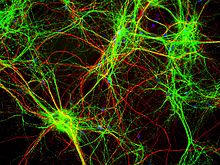Permanent cells are cells that are incapable of regeneration. These cells are considered to be terminally differentiated and non-proliferative in postnatal life. This includes neurons, heart cells, skeletal muscle cells and red blood cells. Although these cells are considered permanent in that they neither reproduce nor transform into other cells, this does not mean that the body cannot create new versions of these cells. For instance, structures in the bone marrow produce new red blood cells constantly, while skeletal muscle damage can be repaired by underlying satellite cells, which fuse to become a new skeletal muscle cell.

Disease and virology studies can use permanent cells to maintain cell count and accurately quantify the effects of vaccines. Some embryology studies also use permanent cells to avoid harvesting embryonic cells from pregnant animals; since the cells are permanent, they may be harvested at a later age when an animal is fully developed.
See also
- Labile cells, which multiply constantly throughout life
- Stable cells, which only multiply when receiving external stimulus to do so
References
- ^ Schumacher, D (2002). "Generation of a permanent cell line that supports efficient growth of Marek's disease virus (MDV) by constitutive expression of MDV glycoprotein E." The Journal of General Virology. 83 (8): 1987–1992. doi:10.1099/0022-1317-83-8-1987. PMID 12124462.
- "Permanent cell | biology".
- Knibbs, Adele; Peckham, Michelle; Paxton, Steve; Paxton, Steve; Knibbs, Adele; Peckham, Michelle (2003). "The Leeds Histology Guide".
{{cite journal}}: Cite journal requires|journal=(help) - Seiler, AE; Spielmann, H (16 June 2011). "The validated embryonic stem cell test to predict embryotoxicity in vitro". Nature Protocols. 6 (7): 961–978. doi:10.1038/nprot.2011.348. PMID 21720311. S2CID 5643556.
This biology article is a stub. You can help Misplaced Pages by expanding it. |